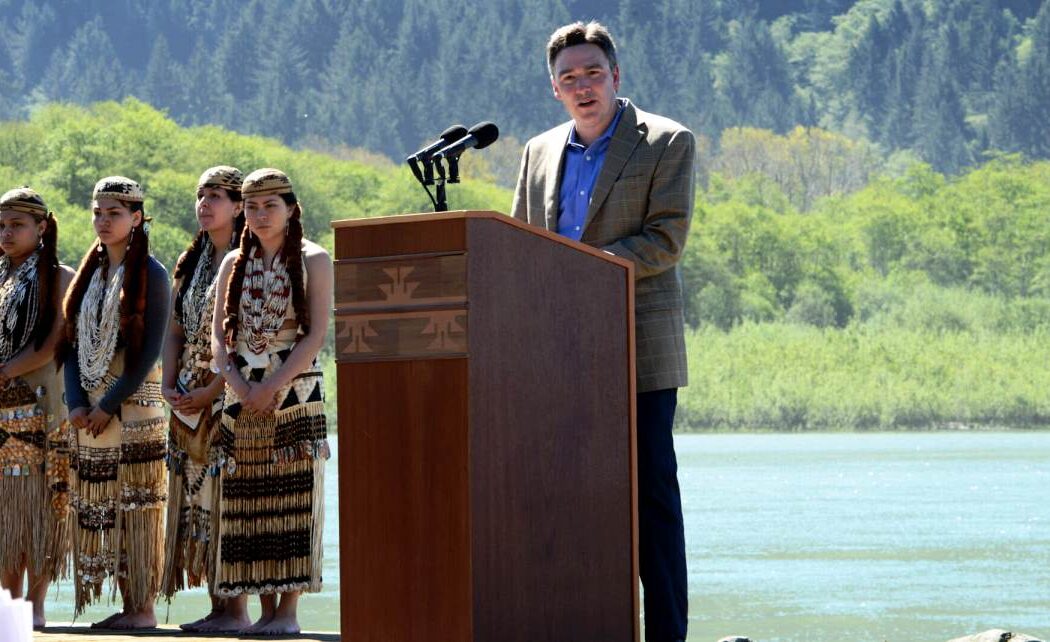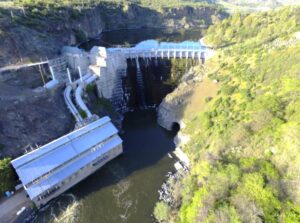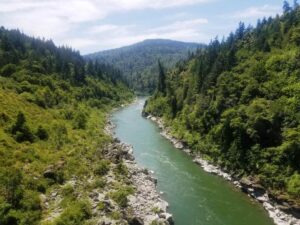On November 17, 2020, California Governor Gavin Newsom joined with Oregon Governor Kate Brown, leaders of the Yurok and Karuk Tribes and Berkshire Hathaway-owned PacifiCorp announced an agreement that marks a critical milestone in one of the most important restoration economy efforts in U.S. history. It will advance the most ambitious salmon restoration and river regeneration effort every seen.
“As Yurok tribal people, it is our sacred duty to bring balance to the Klamath River,” Yurok Tribe Chair Joseph James said.
“At its heart, dam removal is about healing and restoration for the river, for the salmon, and for our people. We have never wavered from this obligation and we are pleased to see dam removal come closer to reality through this agreement. Reaching this important milestone would not be possible without the many tribal people who have dedicated their lives to restoring the river. We want to thank Berkshire Hathaway, PacifiCorp, California, Oregon, and the Karuk Tribe. Although we are excited to be moving forward again, we want to emphasize that the Yurok Tribe will never rest until the dams are out and the river is healed. From the families on the Klamath we want to thank the Buffett family for their support and leadership,” he explained.
The project, when completed, will boost fish populations, revive river health and revitalize Tribal communities, economies and cultures.
The Memorandum of Agreement signed by the states of California and Oregon, the Yurok Tribe, the Karuk Tribe, PacifiCorp and the Klamath River Renewal Corporation (KRRC) describes how the parties will implement the amended Klamath Hydroelectric Settlement Agreement (KHSA) as negotiated and signed in 2016. The KHSA sets the terms for the removal of four Klamath River dams.
“The Klamath River is a centerpiece of tribal community, culture and sustenance and a national ecological treasure,” Governor Newsom said.
“With this agreement, we are closer than ever to restoring access to 400 miles of salmon habitat which will be a boon to the local economy. I am grateful for the partnership between California and Oregon, the Yurok and Karuk Tribes and Berkshire Hathaway that proves when we work together, we can build a better, more inclusive future for all,” he added.
With the Memorandum of Agreement, the parties:
- Jointly ask the Federal Energy Regulatory Commission (FERC) to remove PacifiCorp from the license for the project and add California, Oregon and KRRC as co-licensees for carrying out dam removal. Adding the states as co-licensees provides assurances that the project will have sufficient financial backing while honoring settlement terms that stipulate PacifiCorp would not be a co-licensee for removal;
- Demonstrate their firm commitment to dam removal;
- Agree to nearly double available contingency funds held by KRRC and contractors and, in the unlikely event that additional funds are needed beyond that, Oregon, California and PacifiCorp will share the costs equally to address FERC’s requirement to ensure full funding for the project;
- Confirm that the KRRC will remain the dam removal entity for the project;
- Plan to navigate the final regulatory approvals necessary to allow the project to begin in 2022 with dam removal in 2023. Site remediation and restoration will continue beyond 2023; and,
- Retain the liability protections for PacifiCorp’s customers established in the KHSA.
Taken together, these provisions are intended to resolve FERC’s concerns raised in a July 2020 order and ensure a successful dam removal project.
“This is an incredibly important step forward on the path towards restorative justice for the people of the Klamath Basin, and towards restoring health to the river as well as everyone and everything that depends on it,” Oregon Governor Kate Brown said.
“From time immemorial, the stewardship of the indigenous peoples of the Klamath basin have nurtured the lands, waters, fish and wildlife of this region. In Oregon, the Klamath tribes remember a time when their livelihoods were supported by clean, healthy, and vibrant waters. It is that vision, that promise, that we are working towards restoring for the generations to come,” she continued.
“I want to thank Governor Newsom and Governor Brown for their leadership in bringing everyone together to collaborate and solve a very complex challenge,” Berkshire Hathaway Chairman Warren Buffett said.
“I recognize the importance of Klamath dam removal and river restoration for tribal people in the Klamath Basin. We appreciate and respect our tribal partners for their collaboration in forging an agreement that delivers an exceptional outcome for the river, as well as future generations. Working together from this historic moment, we can complete the project and remove these dams,” he added.
“We deeply appreciate the efforts of Governors Newsom and Brown, the Yurok Tribe and the leadership of Berkshire Hathaway to forge a path forward on dam removal,” Karuk Tribe Chair Russell “Buster” Attebery said. “We are more confident than ever that future generations of Karuk will enjoy the benefits of a healthy Klamath River just as their ancestors did dating back to the beginning of time. Most importantly, this moment is a testament to years of devotion and hard work by the community of activists representing all Tribes on the river who have never tired of demanding justice for their communities.”
Implementation of the amended KHSA requires two approvals by FERC. First, FERC must approve the transfer of the license for the dams from PacifiCorp to the KRRC and the states. Second, FERC must approve the dam removal plan.
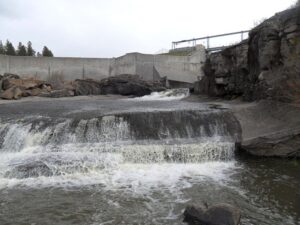 “We are deeply grateful to the parties who negotiated a path forward for this epic project to restore the Klamath River,” KRRC Chief Executive Officer Mark Bransom said.
“We are deeply grateful to the parties who negotiated a path forward for this epic project to restore the Klamath River,” KRRC Chief Executive Officer Mark Bransom said.
“As has been the case numerous times in the past, the signatories to the KHSA have tackled obstacles head on and found creative solutions to daunting problems. But we particularly recognize the personal involvement of Governor Newsom, Governor Brown and Berkshire Hathaway leadership who stepped in to ensure that dam removal proceeds. Once all the necessary approvals are obtained it will be full speed ahead in removing the Klamath dams and allowing salmon to access habitat that has been cut off for a century,” he concluded.
Oregon’s U.S. Senators Ron Wyden and Jeff Merkley jointly said this about the Klamath Dam announcement: “Oregon and California have made the best of a bad situation forced upon the two states when FERC upset the Klamath Hydroelectric Settlement Agreement dam removal process with an unexpected and unwelcome ruling last summer,” said Wyden and Merkley. “We’re glad to see the states step up and all the parties that signed the Klamath settlement reach this agreement, and we look forward to seeing these dams come out just as soon as humanly possible.”
Trout Unlimited lauded the Memorandum of Agreement. “Leadership matters. This is happening because Gov. Newsom, Gov. Brown, and Warren Buffett’s executive team made it happen,” said Chrysten Lambert, Oregon director for Trout Unlimited. “After decades of leadership by the tribes and strong support from conservation and fishing groups, the project is moving forward.”
“Today’s agreement solves the remaining issues associated with the project and clears the way for dam removal,” said Brian J. Johnson, California director for Trout Unlimited. “This is not a back-up plan. This is a better version of the plan.”
Johnson also serves as vice president of the board for the KRRC. Johnson was the board’s designated representative to this summer’s negotiations.
“Really hard projects like this never happen just because they’re the right thing to do,” said Johnson. “They happen when a group of people decides that failure is not an option.”
The MOA responds to a decision by the notoriously corrupt Federal Energy Regulatory Commission (FERC) in July that authorized transfer of the operating license for Iron Gate, Copco I and II, and J.C. Boyle dams from PacifiCorp to the KRRC, but required PacifiCorp to remain as co-licensee. This condition was not anticipated under the KHSA. At that time, Charlton Bonham, director of the California Department of Fish and Wildlife, said, “FERC threw us a curve ball. But this teams hits curves.”
Bonham and Richard Whitman, director of the Oregon Department of Environmental Quality, spearheaded the states’ efforts to resolve issues created by the FERC decision. “Oregon and California stepped up when we really needed it,” said Lambert. “The terms of the MOA reflect their long dedication to and progressive investment in restoring the Klamath River and its salmon and steelhead fisheries.”
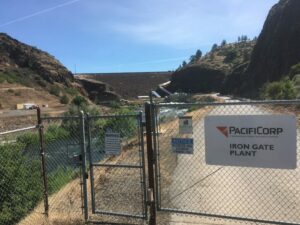
Iron Gate dam, lowest of the four Klamath River dams slated for removal. Photo courtesy of Trout Unlimited.
The MOA reflects the ongoing commitment and resolve of parties to the amended KHSA to physically remove the dams and achieve a free-flowing river, volitional fish passage, and site restoration. To that end, it describes a procedural path forward before the FERC in support of dam removal, by describing steps necessary to implement Klamath Dam removal plans that meet PacifiCorp’s need to transfer ownership of the dams prior to their removal while addressing FERC’s concerns, in two specific ways.
First, the MOA specifies that PacifiCorp will be removed as a licensee for the project, and California and Oregon added, along with KRRC, as co-licensees for purposes of dam removal. California, in particular, has extensive experience as a FERC licensed dam operator. The MOA also commits PacifiCorp and the states to create an additional contingency fund in the amount of $45 million to ensure that dam removal will occur and be completed. PacifiCorp and the states will each contribute $15 million for this additional contingency fund and share any cost overruns that may occur over this amount equally. This additional contingency is intended to express the full commitment by PacifiCorp and states to dam removal.
Dam removal through the Klamath Hydroelectric Settlement Agreement, or KHSA, is the keystone to decades of effort by tribes, resource agencies, and conservation groups to restore the Klamath River and its once-prolific runs of salmon and steelhead. The KHSA provides for removal of four antiquated dams currently owned by PacifiCorp and reflects the utility’s determination that continuing to operate the dams is not in the best interest of ratepayers.
Years of analysis have shown that removing the Klamath dams is the best deal for ratepayers and the best way to restore the Klamath River’s legendary runs of native salmon, steelhead and four species of sucker fish.
Trout Unlimited is a signatory to the KHSA, and has worked closely with all Klamath stakeholders over the past 20 years to resolve water management challenges in the Klamath Basin, to develop cooperatively a permanent fix for the impacts of the four dams on fish, and to restore habitat, fish passage and water quality in Klamath Lake and its tributaries.
Collaboration toward that end between the tribes and conservation and commercial fishing groups, according to Johnson, “is a model for how dedicated coalitions can work together.”
This week’s agreement is the latest in a series of key milestones that reflect the efforts of this partnership. In 2006, TU attorneys worked with others from the conservation and fishing community and tribal governments in a “trial type” administrative proceeding guaranteeing volitional fish passage into the upper basin and ensuring that dam removal would be the most cost-effective option.
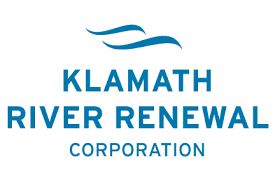 In 2010, the coalition successfully negotiated the KHSA. In 2016, after Congress failed to ratify the agreement, TU and other coalition members identified paths forward via the FERC relicensing process, with innovative insurance mechanisms, and amended the settlement agreement. When FERC issued its decision this summer, tribal members and members of the conservation community, including TU, elevated the issue in the public arena and brought Berkshire Hathaway leadership to the negotiating table. Ultimately, the company met the states halfway to craft a solution that was better than the original.
In 2010, the coalition successfully negotiated the KHSA. In 2016, after Congress failed to ratify the agreement, TU and other coalition members identified paths forward via the FERC relicensing process, with innovative insurance mechanisms, and amended the settlement agreement. When FERC issued its decision this summer, tribal members and members of the conservation community, including TU, elevated the issue in the public arena and brought Berkshire Hathaway leadership to the negotiating table. Ultimately, the company met the states halfway to craft a solution that was better than the original.
In the upper Klamath Basin, TU is the lead entity driving restoration and reconnection of coldwater habitats through projects that improve quality, boost streamflows, and help native fish, landowners and local communities. Coldwater habitat in this region has been significantly disconnected over the past century, and there are significant water quality issues in and adjacent to Klamath Lake related to legacy land use. TU’s formula for success, based on cooperative partnerships with ranchers, private landowners and resource agencies typically employs local contractors to accomplish design, construction and monitoring.
These projects reduce nutrient or sediment pollution, help stabilize water temperatures, improve instream flows to enhance opportunities for spawning, rearing and migration, and improve stream channel and ecological function. They also are helping to prepare the upper basin for the return of salmon and steelhead to the watershed above Klamath Lake after the four dams are removed, likely beginning in 2022.
Go here to watch a short film about TU’s Upper Klamath restoration work, and go here to read an opinion-editorial by Chrysten Lambert on TU’s vision for success in the Klamath River watershed.
Featured photo (courtesy of Trout Unlimited) shows TU’s Brian Johnson at the 2016 signing ceremony of the Klamath Hydroelectric Settlement Agreement.
All other photos are courtesy of Klamath River Renewal Corporation, unless otherwise credited.

